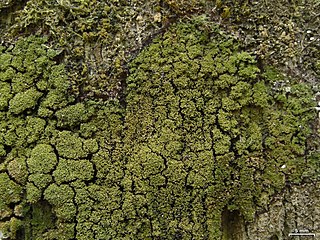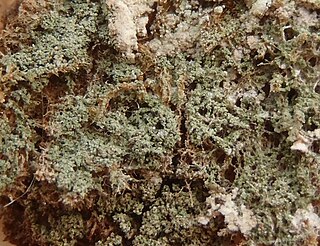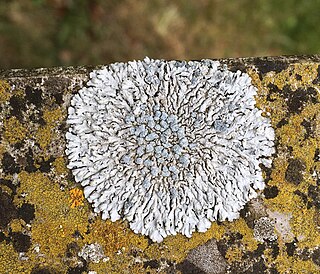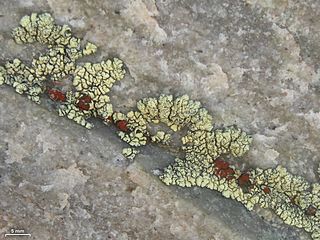
The Physciaceae are a family of mostly lichen-forming fungi belonging to the class Lecanoromycetes in the division Ascomycota. A 2016 estimate placed 19 genera and 601 species in the family.

Phyllopsora is a genus of lichen-forming fungi in the family Ramalinaceae. It was circumscribed by Swiss botanist Johannes Müller Argoviensis in 1894, with Phyllopsora breviuscula assigned as the type species.
Ioplaca is a genus of crustose lichens in the family Teloschistaceae. The genus was circumscribed in 1977 by Czech lichenologist Josef Poelt with Ioplaca sphalera assigned as the type species.

Unguiculariopsis is a genus of lichenicolous fungi in the family Cordieritidaceae. It has 29 species.

Agonimia is a genus of lichen-forming fungi in the family Verrucariaceae.

Psoroglaena is a genus of lichen-forming fungi in the family Verrucariaceae. The genus was circumscribed by Johann Müller Argoviensis in 1891, with Psoroglaena cubensis assigned as the type species.

Physcia caesia, known colloquially as blue-gray rosette lichen and powder-back lichen, is a species of foliose lichenized fungus. First described by Georg Franz Hoffmann in 1784, it is common across much of Europe, North America and New Zealand, and more patchily distributed in South America, Asia, Australia and Antarctica. There are 2 subspecies: P. c. caesia and P. c. ventosa, as well as a number of distinct forms and varieties. Molecular studies suggest that the species as currently defined may be polyphyletic. It is typically pale gray shading to darker gray in the center, and grows in a small rosette, usually some 2–3 cm (0.79–1.18 in) across at maturity. It only rarely has apothecia, instead reproducing most often vegetatively via soredia, which are piled in round blue-gray mounds across the thallus's upper surface. It grows most often on rock—principally calcareous, but also basaltic and siliceous—and also occurs on bone, bark and soil. It is nitrophilic and is particularly common on substrates where birds perch.

Muellerella lichenicola is a species of lichenicolous fungus in the family Verrucariaceae. It was first formally described as a new species in 1826 by Søren Christian Sommerfelt, as Sphaeria lichenicola. David Leslie Hawksworth transferred it to the genus Muellerella in 1979.

Squamulea is a genus of lichen-forming fungi in the family Teloschistaceae. It has 15 species. The genus was circumscribed in 2013 by Ulf Arup, Ulrik Søchting, and Patrik Frödén, with Squamulea subsoluta assigned as the type species. Five species were included in the original account of the genus. The genus name alludes to the squamulose growth form of most of its species. Squamulea has a worldwide distribution; when the genus was originally created, the centre of distribution was thought to be in southwestern North America.
Alfred Mycolayovych Oxner was a Ukrainian botanist and lichenologist. His research covered various areas: floristics, taxonomy, phylogenetics, phytogeography, and phytosociology. Oxner founded the National Lichenological Herbarium of Ukraine.
Klára Anna Verseghy was a Hungarian lichenologist. She was the curator of the lichen collection of the Hungarian Natural History Museum in Budapest from 1958 to 1985.
Phoma candelariellae is a species of lichenicolous (lichen-eating) fungus in the family Didymellaceae. It is found in the Central Anatolia Region of Turkey and in Ukraine, where it grows parasitically on the apothecia of the saxicolous (rock-dwelling) lichen Candelariella aurella.
Neobrownliella is a genus of crustose lichens in the subfamily Teloschistoideae of the family Teloschistaceae. It has five species. The genus was circumscribed in 2015 by lichenologists Sergey Kondratyuk, Jack Elix, Ingvar Kärnefelt, and Arne Thell, with Neobrownliella brownlieae assigned as the type species. It is a segregate of the large genus Caloplaca. Characteristics of Neobrownliella include a thallus that is continuous or areolate, the presence of anthraquinones as lichen products, a cortical layer with a palisade paraplectenchyma, and the lack of a thick palisade cortical layer on the underside of the thalline exciple. Two species were included in the original circumscription of the genus; an additional three species were added in 2020.
Bryostigma is a genus of lichen-forming fungi of uncertain familial placement in the order Arthoniales. The genus was circumscribed in 1979 by Josef Poelt and Peter Döbbeler, with the muscicolous lichen Bryostigma leucodontis assigned as the type species. A dozen Arthonia species were transferred into the genus in 2020 following molecular phylogenetic analysis of the family Arthoniaceae that showed distinct phylogenetic lineages that were basal to that family. The genus contains several parasitic species that occur on hosts having chlorococcoid photobionts.
Kashiwadia is a genus of lichen-forming fungi in the family Physciaceae. The genus was circumscribed in Sergey Kondratyuk, László Lőkös, and Jae-Seoun Hur in 2014 to contain the species Physcia orientalis, after molecular phylogenetic analysis showed that the taxon occupied an isolated phylogenetic position in the Physciaceae. An additional five species were added to the genus in 2021. The genus name honours Japanese lichenologist Hiroyuki Kashiwadani, who originally described the type species.

Verseghya is a genus of lichen-forming fungi in the family Pertusariaceae. It has two species. The genus was circumscribed in 2016 by lichenologists Sergey Kondratyuk, Laszlo Lőkös, and Jae-Seoun Hur, with Verseghya klarae assigned as the type species. This crustose species is found in South Korea, where it grows on the bark of a wide variety of both deciduous and coniferous trees. Molecular phylogenetic analysis showed that Verseghya klarae occupied a separate phylogenetic branch in the Pertusariaceae, situated between the genera Ochrolechia and Pertusaria and the Lecanora subcarnea species complex. Verseghya thysanophora was transferred to the genus in 2019. It is widely distributed in the Northern Hemisphere.
Bryostigma huriellae is a species of lichenicolous (lichen-dwelling) fungus of uncertain familial placement in the order Arthoniales. Found in South Korea, it was formally described as a new species in 2020 by lichenologists Sergey Kondratyuk and Jae-Seoun Hur.
Rehmanniella is a genus of lichen-forming fungi in the family Teloschistaceae. It contains five species of saxicolous (rock-dwelling) crustose lichens. The genus was circumscribed by lichenologists Sergey Kondratyuk and Jae-Seoun Hur in 2018. The genus name honours Polish geographer, geomorphologist, botanist and explorer Anton Rehmann (1840–1917), who collected bryophytes and vascular plants in South Africa. The genus was originally circumscribed with Rehmanniella wirthii assigned as the type and only species. Four additional species were added to the genus in 2020.

Erichansenia epithallina is a species of saxicolous (rock-dwelling), crustose lichen in the family Teloschistaceae. It is also a lichenicolous lichen species, meaning that it grows on other lichens. Many host genera have been recorded. It occurs in Europe and North America, including Arctic regions.
Oxneriopsis is a genus of lichen-forming fungi in the family Teloschistaceae. It has four species of corticolous (bark-dwelling), crustose lichens.









